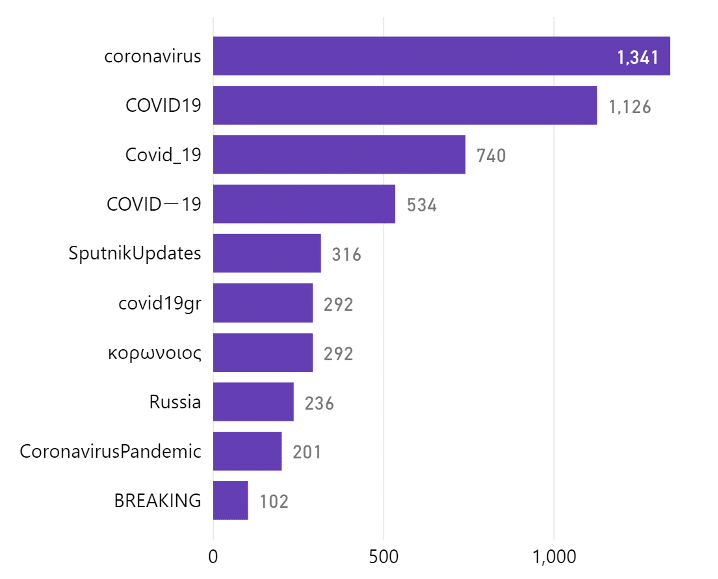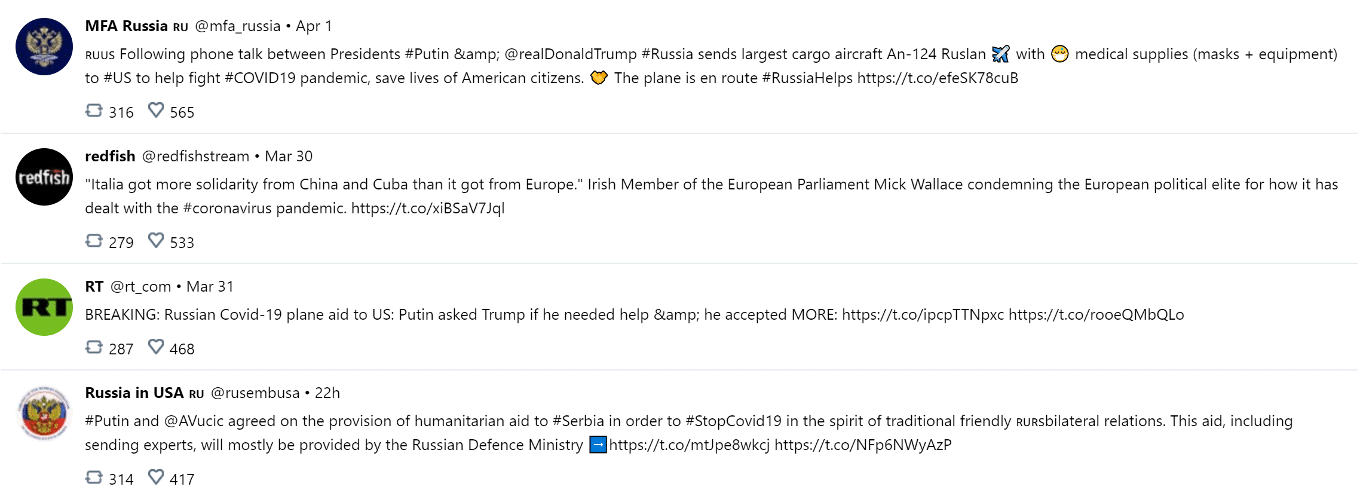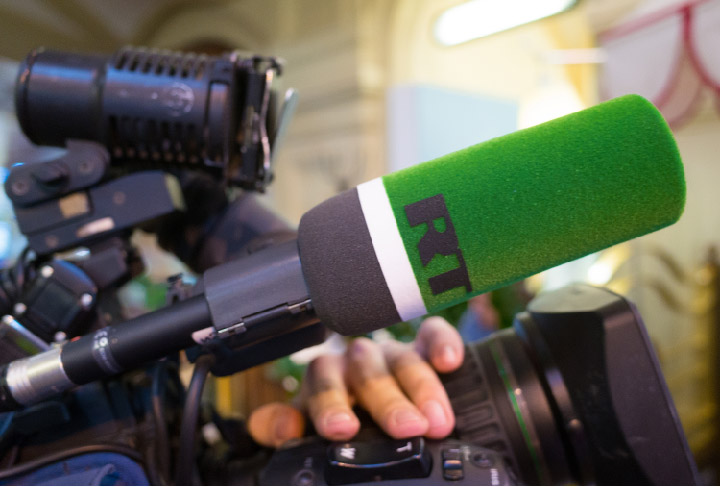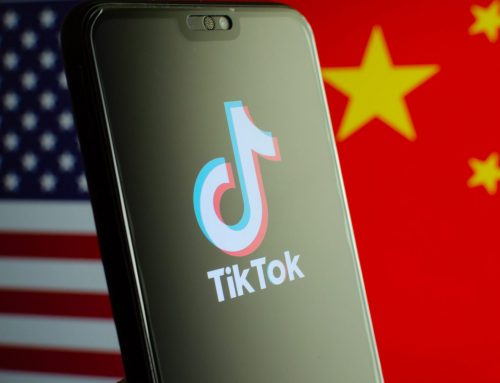Russia Toplines
For the eleventh week in a row, coverage of the coronavirus dominated the Russian media ecosystem last week. As has become the norm, much of this content relayed basic news updates on various aspects of the pandemic. However, one important theme this week emphasized Russia’s medical aid to other countries, particularly the United States. A few articles also highlighted areas of geopolitical tension that the pandemic has exacerbated, such as the transatlantic relationship and the divide between the West and authoritarian regimes.
China Toplines
The coronavirus was the most prominent topic by far within the Chinese media ecosystem last week. Much of this coverage consisted of basic news updates, but China’s humanitarian aid to other countries facing outbreaks received significant emphasis. At the same time, output also heavily disputed any suggestions of problems with Chinese medical equipment donations or China’s response to the outbreak more generally, often firing back with criticism of Western countries and officials making these suggestions. As has been the case since the beginning of the outbreak, Chinese media outlets this week continued their efforts to portray China as a benevolent global leader in this time of crisis.
Russia
Russian state-funded media and government and diplomatic corps accounts:
Top 10 Hashtags — March 28-April 3:

The Hamilton dashboard collected about 13,000 tweets from Russian state-funded media and government Twitter accounts the week of March 28-April 3 (figures as of 1pm April 3). Seven of the top ten hashtags were related to the coronavirus pandemic, including the top four. A little over 4,000 tweets mentioned “virus” and about 3,270 mentioned “covid.” Excluding tweets from three accounts that typically receive very high engagement regardless of topic (@actualidadrt, @rtultimahora, and @sputnik_tr), and thus may mask more widespread trends, half of the top tweets by likes addressed “solidarity” and medical aid from Russia to Italy, Serbia, and the United States. One further top tweet highlighted Chinese and Cuban assistance to Italy in combatting the outbreak there:



 (Translation: Today another Russian flight with ventilators and medical supplies for Italy landed in Verona.)
(Translation: Today another Russian flight with ventilators and medical supplies for Italy landed in Verona.)
Hashtags associated with tweets about Russia’s aid to other countries last week included #RussiaHelps (6 uses) and #DallaRussiaconAmore (Italian for “From Russia with love”: 10 uses).
Websites
Russian government-funded websites:
Out of a little more than 1,500 articles collected from Russian government-funded news websites last week, about 1,050 mentioned “virus” in the first 200 words, including all of the top ten articles as measured by Facebook engagement (reactions, comments, and shares; each ranking contained the same ten articles). Four of these top articles dealt with Russian or Chinese medical aid to the West, and another covered China’s reaction to criticism of its efforts to contain the virus in Wuhan. Examples included:
“Russian Covid-19 aid plane to US: Putin asked Trump if he needed help & he accepted, Kremlin spokesman says,” RT, March 31, 2020.
“A cargo plane loaded with medical supplies and protection equipment may depart for the US by the end of Tuesday, the Kremlin said, after a phone call between US President Donald Trump and Russian President Vladimir Putin. The issue of protective gear was raised during the Monday phone talks, with Putin asking if the US needed help and Trump accepting, Kremlin spokesman Dmitry Peskov told reporters on Tuesday. Moscow suggested the aid in anticipation that the US will be able to return the favor if necessary, once its manufacturers of medical and protective equipment catch up with demand, Peskov said.”
“First train with medical supplies for Europe leaves Wuhan as China eases Covid-19 lockdown,” RT, March 28, 2020.
“Beijing has resumed its railway freight service between Wuhan and Europe by delivering medical aid to Germany as authorities work to lift strict quarantine measures after the number of new cases Covid-19 dropped . . . The delivery will be the first China-EU cargo freight operation from Wuhan since the city was placed under strict quarantine in January after the Covid-19 outbreak.”
“US bought France-bound face masks for CASH from China – French official to RT,” RT, April 1, 2020.
“The US bought out a planeload of Chinese-made face masks right on the tarmac just as the haul of the much needed protective gear was about to set off for France, the head of a French region told RT.
“Facing shortages of protective equipment amid the coronavirus outbreak, France has turned to China to procure the much-needed face masks.”
“This ‘dictatorship’ just beat pandemic & you’re just JEALOUS, Chinese embassy in France tells the West,” RT, March 30, 2020.
“Western media and governments refusing to give China credit for battling Covid-19 in Wuhan simply envy its efficiency, the Chinese embassy in France said as it took a jab at how the West was coping with the pandemic.”
In total, at least 50 articles covered humanitarian assistance related to COVID-19 (based on the appearance of “assistance” in the first 200 words). Articles on this topic included pushback on the idea that Russia’s medical aid to other countries is not wholly motivated by humanitarian concern, as well as claims that Russia’s aid to Italy was not useful. Some examples:
“Top brass slams La Stampa’s claims about Russian mission in Italy as propaganda,” TASS, April 2, 2020.
“Claims being made by the Italian newspaper La Stampa about the mission of the Russian military in Italy who help fight against coronavirus infection are based on old-time anti-Soviet propaganda manuals, Russian Defense Ministry spokesman, Igor Konashenkov said on Facebook. The Russian Defense Ministry has noted La Stampa’s attempts at discrediting Russia’s mission. Konashenkov points out that the newspaper uses speculations about the ideals of freedom of speech and pluralism to juggle with the cheapest Russophobic fakes of the Cold War era, mentioning as its sources some ‘opinions’ voiced by anonymous ‘high-ranking officials.’”
“Sick West Goes Viral,” Column, Sputnik News, April 2, 2020.
“The world is in a sick place. We’re not just talking about the escalating coronavirus pandemic, serious though that is with global deaths doubling over the past week. What is also sick is the way gestures of solidarity are being cynically twisted. Take the arrival of Russian medical aid to the US this week . . . Even before the Antonov-124 cargo plane touched down at JFK airport certain US media outlets were labelling the gesture of solidarity as a “propaganda gimmick” by the Kremlin. It was surmised that the Russian response to the US request for aid was “to push efforts for relief from sanctions” imposed by Washington. The cynical inference is that supposed Russian conniving and deceit knows no bounds in the black art of manipulation.”
Broadcasts
Russian state-owned media:
Out of almost 120 videos collected from Russian state-owned media on YouTube last week, over 100 dealt with some aspect of the coronavirus. Videos of interest covered the intersection of the pandemic with various Kremlin talking points, including media criticism, Russian medical aid to the United States, criticism of U.S. domestic problems, and whether proposed and existing government powers in the U.K. encroach too far on civil liberties. Examples of each included:
“Reporters goad Trump to go after China, Iran,” RT America, April 2, 2020.
“In the midst of the COVID-19 coronavirus crisis, reporters at the White House still can’t resist injecting their own foreign policy priorities and going after President Trump for perceived missteps.”
“Trump confirms coronavirus aid deal with Russia,” RT America, March 31, 2020.
“A Russian cargo plane loaded with much-needed medical supplies and protective equipment is bound for the US following Russian President Putin’s Monday phone call with US President Trump.”
“Coronavirus: Wealthy vs. poor,” RT America, April 1, 2020.
“The COVID-19 coronavirus has brought a record number of 865 deaths in a single day to the U.S. This brings America’s death toll to over 4,300. While many of the wealthy are recovering, medical experts are worried that the coronavirus could kill thousands of the poorest people. The Trump administration predicts that between 100,000 and 240,000 people could die before the crisis is over.”
“COVID-19 eroding civil liberties — gone for good?” RT America, March 31, 2020.
“Legal and media analyst Lionel of Lionel Media joins Rick Sanchez to weigh in on fears over the curtailment of civil liberties and medical privacy in the wake of the COVID-19 coronavirus pandemic.”
“How greed killed the US’ supply of ventilators,” RT America, March 31, 2020.
“Rick Sanchez explains how medical equipment giant Covidien acquired Newport Medical to prevent the mass-production of inexpensive and portable ventilators, thus dooming the US to the shortage of ventilators it sees amid the COVID-19 coronavirus pandemic. Then “Redacted Tonight” host Lee Camp joins Rick Sanchez to weigh in on the “infuriating” dearth of ventilators and the corporate greed that led to it.”
“Should we be tracked to help map viral spreading?” RT UK, April 1, 2020.
“DEBATE: Should we allow the government to track our phones under the pretense of helping map the paths of infection? A necessary measure? An overarching control of privacy? And can the information be guaranteed to be handled properly?”
China
Chinese state-funded media and government and diplomatic corps accounts:
Top 10 Hashtags — March 28-April 3:

The Hamilton dashboard collected about 12,000 tweets from Chinese state-funded media and government Twitter accounts the week of March 28-April 3 (figures as of 2pm April 3). At least four of the top ten hashtags related to the pandemic, including three of the top four. The accounts used #COVID19 almost twice the number of times as the next most-used hashtag, #coronavirus. In total, more than 4,400 tweets mentioned “covid” and about 2,700 mentioned “virus.” Top tweets by likes related to the pandemic emphasized China’s medical aid to other countries — including pushback against claims that some of its donated medical supplies were defective — China’s progress in combating its own outbreak, and its medical research about the virus. There seems to be some emphasis on international cooperation against the pandemic, implicitly led by China: 

 (Yang Wanming is the Chinese ambassador to Brazil.)
(Yang Wanming is the Chinese ambassador to Brazil.)
Hashtags associated with China’s medical aid to other countries included #EsteVirusLoParamosUnidos (Spanish for “We stop this virus together”: 11 uses) and #ForzaCinaeItalia (Italian for “Come on China and Italy”: 9 uses). According to media reports, bot networks may have helped boost the popularity of these hashtags.
Websites
Chinese government-funded websites:
Out of a little over 3,500 articles collected from Chinese state-funded news websites last week, almost 2,200 mentioned “covid” in the first 200 words. One important theme was China’s medical aid to other countries. A few examples of these articles, including the top article by Facebook engagement, included:
“First aircraft carrying medical supplies from China arrives in U.S.,” CGTN, March 30, 2020.
“An aircraft carrying personal protective equipment (PPE) donated by China, along with U.S.-purchased medical supplies, arrived in New York on Sunday. The plane is the first in a series of flights over the next 30 days organized by the White House to help fight the coronavirus, the White House said . . . Along with the goods, Chinese company Huawei donated 10,000 masks, 20,000 articles of protective clothing, 10,000 gloves and 50,000 goggles to New York state. Governor Andrew Cuomo confirmed the donation and thanked Huawei on Twitter.”
“Aid welcomed in Middle East, Europe, Africa,” China Daily, March 30, 2020.
“The spread of COVID-19 is now posing an especially severe challenge to the Middle East, where chronic wars, sanctions, famine, financial collapse and political unrest have hampered efforts to contain the virus’s spread . . . At such a crucial moment, some Chinese medics are fighting alongside their Middle Eastern counterparts, and Chinese expertise and supplies have been warmly welcomed as the region fights the pandemic.”
“First batch of Chinese medical equipment arrives in Croatia,” Xinhua, March 30, 2020.
“The first batch of medical supplies from China, 12.5 tons in total, arrived on Sunday at the Zagreb airport, the Croatian government said, calling it ‘another example of high-quality cooperation’ between the two countries.”
As has been the case since the initial coronavirus outbreak in Wuhan, Chinese state-funded news websites continued to heavily dispute any criticisms of China’s domestic response and sought to portray China as a global leader in the fight against the pandemic. This trend of denying possible mistakes also marked responses to reports that humanitarian aid from China to other affected countries has contained faulty equipment or has ulterior motives:
“Beijing rejects U.S. politicians ‘shameless’ comments on China hiding coronavirus data,” CGTN, April 2, 2020.
“China’s Ministry of Foreign Affairs on Thursday slammed some U.S. politicians’ “shameless” remarks that cast doubt over China’s reporting of coronavirus cases in the country. Spokesperson Hua Chunying said during a daily briefing that China has been open and transparent about the coronavirus outbreak that began in the country late last year. She said the United States should stop politicizing the health issue and instead focus on the safety of its people.”
“Serbian ambassador hails bond with China, slams accusations of ‘coronavirus diplomacy,’” Global Times, March 30, 2020.
“Editor’s Note: When Serbian President Aleksandar Vucic issued a call for help to fight the outbreak of COVID-19, China was the first country that answered, sending shipments of medical supplies and deploying medical experts. Meanwhile, ordinary Chinese people also voluntarily mobilized to support Serbia in the battle against the pandemic, a reflection of the deep bond shared by the two countries. Serbia is currently taking advice from Chinese medical staff to implement a series of measures, including the building of makeshift hospitals . . . However, the humanitarian aid China is offering to Serbia is being maliciously attacked by some Western media as having other “ulterior motives.””
“Chinese Embassy in Philippines: All donated test kits meet standards,” CGTN, March 29, 2020.
“All of the test kits donated by China to the Philippines to combat coronavirus are of high quality and have no accuracy problems, the Chinese Embassy in the Philippines said in a statement on Sunday.”
“Inadequate understanding, disrupted transportation hinder China’s testing kits exports,” Global Times, March 28, 2020.
“As the coronavirus outbreak rages across the world, China is churning out medical supplies and testing kits to support the overseas battles against the virus. However, testing kits providers in China reported that some foreign countries’ inadequate understanding of different testing methods, some misplaced order consultations, and logistical obstacles are the biggest difficulties in exporting testing kits.”
“Chinese Embassy in Spain: China’s image shouldn’t be smeared amid pandemic,” CGTN, March 28, 2020.
“The Chinese Embassy in Spain will not allow any foreign media to smear the image of China and Chinese products at will, Yao Fei, charge d’affaires of the Chinese Embassy in Spain said on Friday. Some Spanish media Thursday reported that China-supplied fast test kits for the novel coronavirus have high error rates.”
Broadcasts
Chinese state-owned media:
The Hamilton dashboard collected almost 150 videos posted by Chinese state-owned media on YouTube last week. As on other platforms, the majority of these videos addressed some aspect of the pandemic. China’s medical aid to other countries, often combined with messaging emphasizing the idea of China’s global leadership in this crisis, constituted a key theme. Examples included:
“Chinese Aid for COVID-19 Control Arrives in Moscow,” CCTV Video News Agency, April 2, 2020.
“A Russian transport plane carrying the Chinese government’s humanitarian aid from Beijing arrived in Moscow on Thursday to support Russia’s fight against COVID-19.”
“What the U.S. can learn from China in fighting COVID-19,” CGTN America, March 31, 2020.
“As the U.S. scrambles to contain COVID-19, parts of China are getting back to work. Here’s what the U.S. could learn from China’s COVID-19 response.”
“Serbian Prime Minister Appreciates China’s Support in Pandemic Control,” CCTV Video News Agency, March 29, 2020.
“The support from China has saved jobs and lives in Serbia, said Serbian Prime Minister Ana Brnabic. The Serbian Prime Minister made the remarks during an interview with the China Global Television Network (CGTN) on Friday.”
The views expressed in GMF publications and commentary are the views of the author alone.






